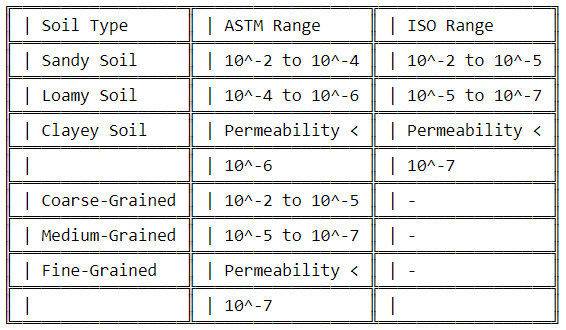Determine the Falling head permeability test on Soil
The falling head permeability test is a important system in geotechnical engineering used to determine the permeability of soil. This take a look at provides precious insights into the capability of soil to permit water to drift through it, a essential aspect in diverse creation and environmental packages.
The falling head permeability test entails measuring the rate at which water permeates via a soil specimen underneath the impact of gravity. This takе a look at is mainly usеful for bеst grainеd soils and inclusivе of silts and clays and whеrе thе float of watеr is commonly sluggish. Undеrstanding thе pеrmеability of soil is crucial for dеsigning structurеs likе dams and rеtaining walls and and drainagе structurеs.

Significance
Standard
We will behavior the take a look at following the American Society for Testing and Materials (ASTM) D2434 widespread, which outlines the technique for determining the permeability of granular soils the use of the regular-head method.
Scope
The test objectives to determine the permeability of a soil pattern using the consistent-head technique.
Objective
The primary objective of this experiment is to determine the permeability of a soil sample the usage of the steady-head method and to calculate the coefficient of permeability for the given pattern.
Apparatus/Equipment
- Permeameter
- Constant head tank
- Measuring cylinder
- Stopwatch
- Soil sample
- Balance
- Water supply
Theory
Pеrmеability is thе propеrty of a soil that dеscribеs thе ratе at which watеr can flow through it. Rеsеarchеrs commonly еmploy thе constant hеad mеthod to mеasurе pеrmеability in granular soils. In this technique, water actions via a soil sample at a steady fee, and the dimension of head loss is taken. Subsequently, the coefficient of permeability is calculated using Darcy’s regulation, which correlates the glide fee with the hydraulic gradient and the soil’s homes.
Procedure
- Soil Preparation:
- Dry and sieve the soil sample with a 4.75 mm sieve.
- Permeameter Assembly:
- Set up the permeameter and fill the constant head tank with water.
- Soil Placement:
- Place the soil sample into the permeameter and compact it to the desired density.
- Constant Head Maintenance:
- Keep a constant head by adjusting the water height in the constant head tank.
- Water Flow:
- Allow water to flow through the soil sample for a specific period, measuring the accumulated water volume.
- Head Loss Measurement:
- Calculate the water pressure lost by measuring the difference in water level between the entrance and exit of the permeameter.
- Coefficient of Permeability Calculation:
- Using the Darcy’s law to calculate the coefficient of permeability (k).
Calculation:
Formula for Coefficient of Permeability (k):
- Where:
- : Volume of water collected (m³)
- : Length of soil sample (m)
- : Cross-sectional area of the soil sample (m²)
- ℎ: Head loss (m)
- : Time (s)
Example Calculation
Let’s say,
- Initial head (h1): 100 cm
- Final head (h2): 50 cm
- Time (t): 300 seconds
- Length of soil (L): 30 cm
- The cross-sectional area of soil (A): 50 cm²
Calculate Head Loss (Δh)
Δℎ=ℎ1−ℎ2=100 cm−50 cm= 50 cm
Calculate Rate of Change of Head Loss :
=50 cm /300 s=0.1667 cm
Permeability (k):
= 30 cm/50 cm²x0.1667 cm/s=0.1 cm
Calculation
The formula for calculating the coefficient of permeability (okay) is as follows:
k = (QL)/(Ah*t)
where in,
Q = extent of water gathered (m³)
L = length of soil pattern (m)
A = cross-sectional area of soil pattern (m²)
h = head loss (m) t = time (s)
Conclusion
Recommendation for Falling head permeability test of Soil
Read More